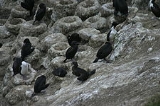
Stewart Island Shag
Encyclopedia
The Bronze Shag also known as the Stewart Island Shag or Stewart Shag, is a species of shag endemic
to the southernmost parts of the South Island
of New Zealand
, from the Otago Peninsula
south to the Foveaux Strait
, and to Stewart Island/Rakiura
, from which it takes its name.
The species is dimorphic
in appearance. Roughly half the individuals are mostly dark bronze, but with white patches, similar to the King Shag
; the remainder are bronze all over. The two morphs breed together indifferently. These chunky birds are 65–75 cm (22–30 in) and weigh 1.8-3.9 kg (4-8.6 lbs).
Bronze Shags breed colonially, making raised cup nests out of organic material and guano. Colonies are large enough to be strikingly visible, and are used year after year; there is a notable one on the northern shore of Taiaroa Head
at the mouth of Otago Harbour
. They feed in coastal waters, rarely if ever being seen inland or far out to sea.
They are related to the other blue-eyed shag
s.
Endemic (ecology)
Endemism is the ecological state of being unique to a defined geographic location, such as an island, nation or other defined zone, or habitat type; organisms that are indigenous to a place are not endemic to it if they are also found elsewhere. For example, all species of lemur are endemic to the...
to the southernmost parts of the South Island
South Island
The South Island is the larger of the two major islands of New Zealand, the other being the more populous North Island. It is bordered to the north by Cook Strait, to the west by the Tasman Sea, to the south and east by the Pacific Ocean...
of New Zealand
New Zealand
New Zealand is an island country in the south-western Pacific Ocean comprising two main landmasses and numerous smaller islands. The country is situated some east of Australia across the Tasman Sea, and roughly south of the Pacific island nations of New Caledonia, Fiji, and Tonga...
, from the Otago Peninsula
Otago Peninsula
The Otago Peninsula is a long, hilly indented finger of land that forms the easternmost part of Dunedin, New Zealand. Volcanic in origin, it forms one wall of the eroded valley that now forms Otago Harbour. The peninsula lies south-east of Otago Harbour and runs parallel to the mainland for...
south to the Foveaux Strait
Foveaux Strait
Foveaux Strait separates Stewart Island/Rakiura, New Zealand's third largest island, from the South Island. Three large bays, Te Waewae Bay, Oreti Beach and Toetoes Bay, sweep along the strait's northern coast, which also hosts Bluff township and harbour. Across the strait lie the Solander...
, and to Stewart Island/Rakiura
Stewart Island/Rakiura
Stewart Island/Rakiura is the third-largest island of New Zealand. It lies south of the South Island, across Foveaux Strait. Its permanent population is slightly over 400 people, most of whom live in the settlement of Oban.- History and naming :...
, from which it takes its name.
The species is dimorphic
Polymorphism (biology)
Polymorphism in biology occurs when two or more clearly different phenotypes exist in the same population of a species — in other words, the occurrence of more than one form or morph...
in appearance. Roughly half the individuals are mostly dark bronze, but with white patches, similar to the King Shag
King Shag
The Rough-faced Shag , also known as New Zealand King Shag or King Shag, is a rare bird endemic to New Zealand.- Description :...
; the remainder are bronze all over. The two morphs breed together indifferently. These chunky birds are 65–75 cm (22–30 in) and weigh 1.8-3.9 kg (4-8.6 lbs).
Bronze Shags breed colonially, making raised cup nests out of organic material and guano. Colonies are large enough to be strikingly visible, and are used year after year; there is a notable one on the northern shore of Taiaroa Head
Taiaroa Head
Taiaroa Head is a headland at the end of the Otago Peninsula in New Zealand, overlooking the mouth of the Otago Harbour. It lies within the city limits of Dunedin...
at the mouth of Otago Harbour
Otago Harbour
Otago Harbour is the natural harbour of Dunedin, New Zealand, consisting of a long, much-indented stretch of generally navigable water separating the Otago Peninsula from the mainland. They join at its southwest end, from the harbour mouth...
. They feed in coastal waters, rarely if ever being seen inland or far out to sea.
They are related to the other blue-eyed shag
Blue-eyed shag
The blue-eyed shags are a group of closely related cormorant taxa. All have a blue, purple or red ring around the eye ; other shared features are white underparts and pink feet....
s.

